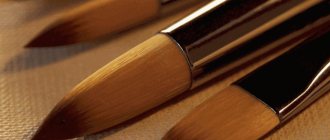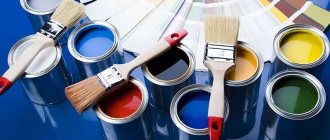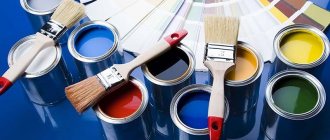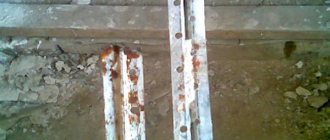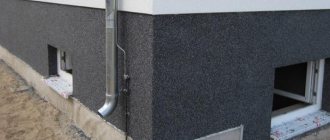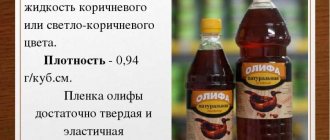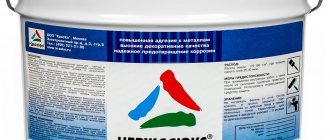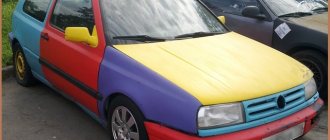Paints: types, parameters, operation
The first thing that needs to be clear before starting to work with an airbrush is the consistency of the paint that you will be dealing with.
Important! In airbrushes, only finely dispersed paint is allowed. In fact, this means that the structure of the paints should not contain large particles so that they do not clog the nozzle of the device.
However, all modern airbrush paints contain many additives and additives (retarder or retarder, etc.). Such additives make the application process more efficient, allowing for new artistic techniques that are not possible with conventional spraying. In some cases, the paint takes longer to dry.
The method of application also differs. For example, water-based acrylic paint can be applied in one or several stages. In this case, it all depends on the task at hand, whether there is a need to create transitions and halftones. Urethane mixtures must be varnished. A multi-component composition must be applied in 3 stages.
What is important to consider when choosing a paint and varnish material
When selecting a paint and varnish product for an airbrush, you should definitely pay attention to how compatible the composition is with the model of the device being used. The reputation of the manufacturing company, as well as the lifespan of the product, will also play a big role. The type of paint for the device should be selected depending on the desired result. Only if you use reliable and high-quality airbrush paints can you make a spectacular image with your own hands. Give preference to those options that do not contain toxic components.
Acrylic paint and its features
Acrylic airbrush paints are the most popular compositions for application to various surfaces. This composition has many significant advantages that make it universal for application.
- The color palette has many gradations. Both neutral colors and shades stand out. There are rich, bright colors, which allows you to convey contrast.
- Increased level of hiding power. This item eliminates the need for re-application. Unlike other types of mixtures, in this case there is no need to apply paint in several layers.
- Excellent adhesive properties. At the same time, the drying time of the paint remains significant, which allows you to experiment with the form of application.
- Non-toxic. The basis of acrylic paints is a water-dispersed mixture.
- Acrylic can be used almost anywhere. The paints are suitable for any type of surface.
Water-based acrylic airbrush paints are extremely convenient when working with your own hands. They are easily diluted to the desired consistency. To mix acrylic paints, it is enough to use distilled water.
It is important to remember that water-based acrylic paint hardens once it dries. A thin layer of plastic forms on the painted surface. This layer has elastic properties, but it also perfectly protects the design from external influences, incl. and temperature changes.
Acrylic paints are easy to wash off. To do this, you need to have special paint removers. However, washing can also give an interesting effect, which is what some designers and artists use.
Advice! For beginners working with an airbrush, acrylic paints are best suited. They do not require any additional manipulations, either before or after application.
The main types of paint and varnish products for airbrushing
Currently, airbrushing is used not only for vehicle decoration. A variety of designs made using an airbrush can be found on walls and furniture, on computer equipment and even on smartphones. If you have artistic talent, you can make such images yourself. The most important thing is to be very responsible when choosing paints suitable for an airbrush.
It is equally important to choose the right soil for this process.
All paints intended for use with an airbrush can be divided into three large groups:
- water-soluble acrylic compounds;
- base urethane paints;
- multicomponent multistage compositions.
It is important to note that they all differ in the method of application. Thus, water-based acrylic products can be sprayed in either one or two stages - depending on the result you want to get.
One of the prerequisites for using urethane paints is varnishing. And multi-component paint compositions are always applied in three stages.
Features of acrylic compositions
One of the most popular and sought-after types of paints and varnishes are water-based acrylic airbrush paints. They are characterized by many advantages, among which are:
- a wide color palette - from neutral translucent shades to rich and bright ones;
- high level of hiding power, eliminating the need for multi-layer paint coating;
- good adhesion, which, in combination with a significant reserve of time for hardening, allows you to create interesting effects when applied;
- absolute non-toxicity due to its water-dispersed base;
- Possibility of use on almost any type of surface.
High-quality water-based acrylic airbrush paints are very convenient for DIY application. They are easy to dilute to obtain the required consistency by mixing with a certain amount of distilled water.
To wash off such a coating, it is necessary to use special high-quality chemicals. This feature of acrylic paints is greatly appreciated by many artists, because it makes it possible to create drawings with interesting effects.
Nitroenamels - characteristic features
The main competitor of liquid acrylic paint for airbrushing is nitro enamel, which is very widely used in the design of automotive vehicles.
These tools also have many advantages and disadvantages that make your work much easier:
- They dry several times faster compared to acrylic products.
- With their help it is much easier to apply perfect thin lines.
- Using such tools, you can create translucent fills that look very impressive.
However, nitro paints are not without certain disadvantages. In particular, the tones and shades are less bright and expressive, and their hiding power is far from the best. Using two different colors, it is almost impossible to achieve a beautiful tone - to prevent the appearance of a grayish tint, you should use a light base.
Due to the fact that not all airbrush models are suitable for working with nitro paints, you should carefully study the information indicated on the packaging of the product you have chosen.
Please also note that nitro paint compositions are highly toxic. Therefore, it is recommended to use them in special boxes where high-quality ventilation is provided.
In addition, all work must be carried out in special equipment.
Watercolor and its features
Another type of paint that you can use to apply your own airbrush design is watercolor. Of course, it is only suitable for paper and some types of decorative plaster, so it is widely used in interiors. It is recommended to use such paints for those who wish to acquire artistic skills and improve them.
Watercolors are characterized by the following properties:
- ease of mixing and rinsing;
- absolute absence of harmful substances in the composition;
- ease of spraying.
Currently, both dry watercolor paints for airbrushing and those made in the form of a water-based paste are available. To obtain the required consistency, simply dilute them with plain water.
Nitroenamel and its features
The second most popular application method. Learning to paint with an airbrush using nitro-enamel paints is a little more difficult, but this experience can be very useful. Most often, this type of paint is used for decorative application on cars. Nitroenamel has a number of useful properties and advantages, which is why many artists prefer it.
- Drying time. Nitroenamel dries much faster than acrylic. This allows you to get the job done more quickly.
- Rendering fine lines, outlines, contours. No other types of paints are capable of forming a pattern as clearly.
- Semi-transparent fill. This is a decorative effect that occurs during certain manipulations with an airbrush. Adds volume to the picture.
However, these paints are not without some disadvantages. Shades and halftones when applied with nitro paint look less bright and pronounced. The hiding power parameters are also significantly lower than those of acrylic. When working with two colors, it is quite difficult to achieve a clear decorative tone. Experts recommend using a light-colored substrate in case of gray shades.
Important! Not all airbrushes are suitable for working with nitro paint. You will have to buy a special model, which will cost more.
Nitro paint, as you can easily guess from the name, is quite toxic . To work with such material you need a special room. Spraying paints in the air can lead to undesirable consequences. A car body painting box is best suited for such tasks. In such a room there is ventilation and there is no dust. You can remain calm that the nitro paint will end up on an unwanted surface. It is important to remember that nitro paint can only be applied in special clothing. Working without a respirator can have an extremely negative impact on your overall health.
Acrylic
Acrylic paint is universal and easy to use. This paint can be used on any surface, including the surfaces of vehicles. This paint sprays well and dries quickly. Once dry, acrylic paints become very durable. Water-based paints are good for their environmental friendliness, so they can be used indoors.
Due to the rapid hardening process, it becomes impossible to correct the drawing. For this reason, there are special retardant additives for diluting acrylic paint.
Some water-based acrylic paints may fade in the sun. After drying, acrylic does not dissolve in water.
Watercolor paints and features of their use
Airbrush painting can seem daunting for beginners. That is why at first it is important to use paints that are easy to use. Watercolor paints are great for everyday use. The scope of watercolor is most often limited to the surface of paper and plaster. Experts believe that this particular type of paint will be optimal for mastering the art of airbrushing. The main advantages of watercolor paints are:
- excellent mixability;
- very easy to wash off from the surface;
- easy and accurate spraying.
Today there are dry watercolor paints for airbrushing. However, there are also traditional ones, in the form of a water-based paste. Unlike acrylic, watercolor can be diluted with plain water, not distilled water.
On a note! Painting with an airbrush using watercolors is quite simple. This is the best option for gaining first experience and honing existing skills.
What paints to use with an airbrush for painting on cars?
Welcome to kuzov.info!
Let's look at the types of paints that can be used to paint with an airbrush on cars and motorcycles.
For use with an airbrush, the paint must be finely dispersed. This means that the size of the pigment in it must be small enough to pass freely through the airbrush nozzle. Ready-made paints for painting contain various additives (retarders/retarders and others) that allow the paint to be atomized and not dry out prematurely on the needle tip and nozzle.
Acrylic and urethane paints are most often used for painting on cars and motorcycles. We will also consider the use of nitrocellulose and alkyd paints.
When buying airbrush paint, you need to check whether the paint is suitable for the nozzle of your airbrush.
Soil and its varieties
Airbrush painting on metal or plastic also includes pre-treatment, incl. covered with soil. For high-quality application, it is extremely important not only to decide on the type of paint, but also to choose a primer. This material is a primary (base) coating for leveling the surface, which directly determines what type of paint will be used in the work . It is the soil that determines the strength of the paint composition. In addition, some paints simply cannot be applied without a preliminary primer.
For high-quality paint application, the primer must have a number of characteristics:
- high degree of adhesion;
- good hiding power;
- smooth surface, silky texture;
- repellent properties of the coating so that the paint is not absorbed.
There are three main types of soil:
- adhesive;
- epoxy;
- primer-filler.
Adhesive
To create a good bond between the surface to be applied and the paint layer, this type of primer is used. The main advantage of adhesive primer is its rapid drying. In addition, it adheres very well to metal structures and plastic surfaces. This allows you to apply it both to the car body and to plastic elements.
Epoxy
The first thing that is important to know for anyone who prefers to use this type of soil is that the material is very toxic. That is why in the room where it is planned to use the soil, it is necessary to have powerful ventilation. It is advisable to work with such material in a respirator. The main characteristics of epoxy are as follows:
- the application layer is thick;
- very long service life;
- easy to sand;
- Corrosion resistant.
When working with epoxy primer, you should follow the operating instructions. It is important that the metal surface is properly treated before applying primer. If the metal is not clean enough, the primer will not apply evenly.
Advice! Before applying epoxy, do not treat surfaces with acidic agents with an etching effect.
Soil filler
This soil composition is two-component. Most often it is a cross between base acrylic and urethane. This primer can be applied in two ways: on a prepared, cleaned surface or on epoxy. It is highly not recommended to use this type of primer together with acid-based products.
Rating of the best airbrush paint brands
Today there are many paints and varnishes on sale that can be used for airbrushing. Popular brands and products include the following:
- Wicked materials from Createx are highly priced. They are suitable for professional use. Thanks to the high degree of adhesion, the pattern is very durable. Bright dyes are suitable for different types of surfaces.
- ExMix paint is a polyurethane dye produced by a Russian company. The material is water-based and affordable. At the same time, paints are characterized by a limited palette.
- Airbrush Sector is a popular brand that offers paints for budget airbrushes.
- Pro-Color is a company that offers a wide range of budget dyes. They are characterized by economical consumption and high quality.
- Policolor are paints produced by the Italian brand Maimeri. They are characterized by an affordable price, a variety of colors and a thick texture. The dye must be thoroughly diluted, which makes it easier to apply.
See also
Drawings with acrylic paints on fabric for beginners and top 6 painting technologies
Coloring stages
Of course, the process of applying paint to the prepared surface occurs in stages. There are five of these stages in total.
- Selection of sketch. You should come up with a drawing or choose it from thousands of available sketches. It is important to model how it will look on the surface, take into account its size and content so that it fits into the context without violating the integrity and composition. Next, the drawing is transferred to paper.
- Preparing the area for painting work. Everything here is quite simple; it is important to make sure that everything that may be needed during the work process is at hand. In some cases you will have to act quite quickly. You should purchase products to eliminate smudges in advance.
- Selection of paint. A very important stage on which the brightness, saturation, structure and durability of the drawing will depend. Don't skimp when choosing paints.
- The process of applying paint to a prepared surface. If all requirements are met, you can begin painting.
- Drying and fixing the material using varnish. After painting, when the surface is ready for application, additional processing is carried out. Varnishing gives the picture a finished look. The work acquires a glossy structure and retains its properties for a longer period. However, varnishing is not carried out in all cases.
Most often, metal body parts come in the so-called. transport soil. It has a rough texture and external damage, so it needs to be removed first. Further coverage:
- polish;
- wash;
- dried;
- degrease with white spirit.
If all of the above types of work have been completed, you can proceed directly to application. In some cases, the painting process also includes tinting. Tinting is the creation of halftones when applying a paint material to a substrate. This effect is achieved by mixing paints of a certain type and composition. Tinting allows you to create not only shades, but also transitions, which is extremely important when working with an airbrush. The only drawback is the complexity of the process itself. Tinting requires significant skills and experience from the artist.
Types of airbrushes
There are several types of airbrushes:
- by type of paint mixing: internal and external mixing;
- on the method of supplying the solution: gravity, siphon and hybrid;
- by type of starting control: lockable and flow-through;
- according to the order of adjustment of the passage of air and dye: single and double action.
Internal and external mixing
The design of a spray gun with internal mixing requires the presence of additional pipes mounted in the airbrush body. A colorful mixture is formed inside the device. Therefore, you can clearly determine its consumption and regulate the flow. This type of airbrush is especially valuable when applying small images. The more securely the needle is fixed, the more accurate the drawing will be.
There are several types of airbrushes
External mixing is used in simpler devices. The principle of its operation is based on applying paint without additional regulators. In such devices, the mixture is sprayed in an even layer. External mix airbrushes are especially appreciated by beginning artists because they can be used to evenly coat a surface with a uniform layer of paint.
Gravity, siphon, hybrid
With the siphon type of supply, the tank with paint is installed on top, and thanks to gravity, a uniform stream emerges from the nozzle of the device. For beginners, in order to quickly master the operating principle of this type of airbrush, it is better to replace the compressor with an air bulb.
An airbrush with a hybrid feed type is designed to work with dyes of the highest density. The operation of the device is based on the difference in excess pressure. And the tank with dyes can be located both at the top and at the bottom of the device.
Flow-through and lockable
The flow airbrush operates without subsequent adjustment of the spray pattern. This operating principle is used in modern spray guns. After the device starts operating, the master controls the paint supply process only by turning it on and off. It is not possible to adjust the pressure during the process.
Beginners especially appreciate airbrushes with external mixing.
But lockable airbrushes provide the ability to adjust the dye supply density using a trigger. Also, such devices are equipped with an additional paint consumption system for applying layers of the required thickness.
When choosing an airbrush, you should pay attention to:
- size, weight of the device;
- container volume for dyes (at least 2 pieces from 2 ml);
- number of nozzles;
- the presence of a Teflon seal for the needle;
- number of regulators.
Application of paints
Airbrush painting is not as difficult as it might seem at first glance. However, beginners will have to start their training with the basics before they can advance in acquiring the skill of evenly, continuously applying paint to a surface. There are three basic rules, following which you can avoid the most common mistakes.
- It is very important to spray paint over rough paper or a piece of cardboard for the first time. The first injection of paint from the needle dislodges lumps and other structural irregularities that, if they hit the surface, would leave pellets, dots or other artifacts. Of course, starting a drawing with such “spit” from the injector is not the best idea. In addition, when the coloring composition is first supplied, excess pressure is released. To adjust the degree of paint supply, you can limit yourself to a small stream, and then get to work.
- Application of the material should be smooth, without jerking or twitching. If the hand is prone to slight but constant tremors, mastering the skill of continuous smooth feeding will be quite difficult. With a sharp jerk to the side, the applied structure is sprayed at a different angle, which, of course, affects the tone of the pattern. The second big problem is smudges. They also often occur due to uneven application due to jerking. Smudges are especially noticeable when working with vertical material.
- Under no circumstances should you bring the painting device close to the surface to be painted. Under pressure, individual larger drops bounce off and streaks appear, which are then very difficult to eliminate. It is important to always maintain the same distance when applying paints. First of all, this is important for maintaining a tone that is uniform for the entire picture. If it differs in different angles, you will have to make appropriate adjustments.
Advice! Having finished applying paint, you must immediately rinse all components of the airbrush to clean its insides from any remaining material. Particular attention should be paid to the injector and needle. The coloring material must be selected strictly in accordance with the technical parameters of the airbrush!
When using water-based paints, simply rinse the device under running water. When working with other paint materials, special cleaning agents may be required.
Using stencils
Quite often, stencils are used in airbrush drawing. This greatly simplifies the artist's task. However, the quality of the design when applied using stencils remains sketchy; it is impossible to achieve clear detail, depth and volume using this auxiliary tool.
Stencils are:
- disposable;
- reusable.
Important! You can make them yourself or purchase ones that are already commercially available. As a rule, a stencil helps to disguise body flaws, small chips, scratches and abrasions, but significant defects cannot be hidden using painting.
Experts have different opinions about the stencil. Some argue that this is an effective and relatively inexpensive way to quickly transform the body of a car or paint a wall without additional skills. Others argue that after painting through a stencil, a drawing requires significant revision, which in terms of time and effort is not inferior to work started from scratch.
The advantage of using a stencil is its prevalence and accessibility. It is also easy to make from available materials (film, paper) if necessary.
Auto enamels
Such substances need to be diluted using water - filtered or the one that comes with acrylic products. It is the least toxic, which is important when dyeing. It will also dry quickly, which will allow you to quickly apply several layers of paint and varnish products and save your time.
The technique of staining with such substances also has disadvantages. For example, experts note color indexing, which may prevent you from getting the shade you want when mixing.
Tips and tricks for painting fabrics, models, cars
Of course, as in any form of art, fabric painting has its own characteristics. However, metal airbrush masters also have their own secrets, as well as when painting models.
- After applying the airbrush design to the fabric, final ironing should be done. Thermal exposure will help the fabric absorb the dye even better. But it is better to do this through parchment paper at a certain temperature (30 degrees). After this treatment, the design will remain on the surface for a long time.
- When painting a miniature model, you should not spray paint in one place for a long time; your hand should be constantly in motion. The air supply must be carefully adjusted. Applying the next pigment layer is possible only after the previous one has completely dried.
- It is important to feed the paint perpendicularly. If the painting surface is horizontal, then the material supply angle should be 45 degrees.
- It is important to maintain a distance between the object being painted and the airbrush. The closer the device is to the surface being treated, the thicker the lines, and the more saturated the color.
- It is best to remove stains after they have dried. If you try to catch the dripping drop with a dry cloth, a streak may remain. Correcting the consequences of picking up a drop is more difficult than removing a dried drop with sandpaper.
- It is important to keep several containers on hand, each of which you can add color to. This will significantly save time on replacing cartridges. In addition, cleaning such containers is very simple.
- It is better to varnish the surface after waiting for the paint to dry completely. If the technology for applying varnish is not followed, its base will lie unevenly.
Sometimes, when working with small parts of models, you can use not only sandpaper, but also an abrasive used for polishing silver and other metals.
The secrets of airbrush painting allow you to constantly improve your skills. True, the main trick, which all experts without exception constantly talk about, is experience. You need to constantly train and hone your skills. Understanding the process of working with an airbrush and the features of its operation will come with time.

